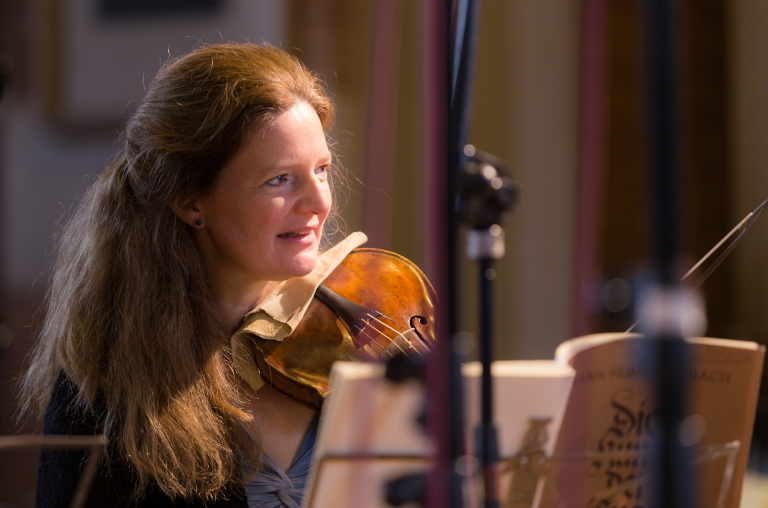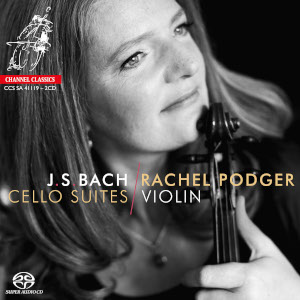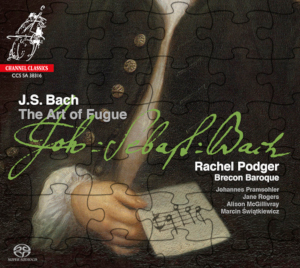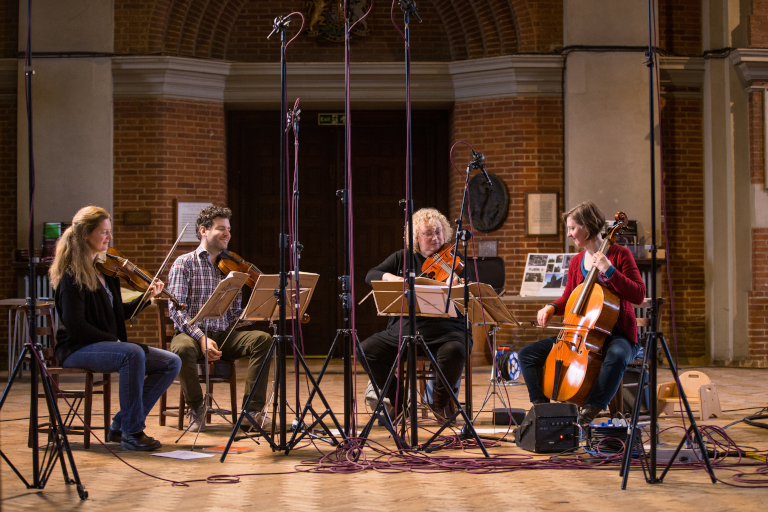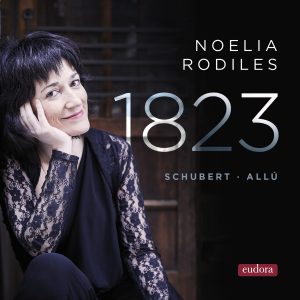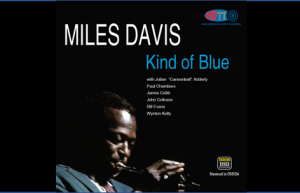Rachel Podger is a joyful music maker, regardless of her choice of composers. And she is one of the best artists performing today on baroque violin and within the world of period instrument performance generally with her Brecon Baroque ensemble.
I wrote enthusiastically about Podger and Brecon Baroque in my article about Channel Classics and the recordings of Jared Sacks. In that article I presented two of her outstanding recordings: Vivaldi's Le Quattro Stagioni (The Four Seasons) and a collection of Baroque chamber works titled Grandissima Gravita.
From the recording session for The Art of Fugue, discussed below.
Today, I'd like to introduce you to two additional, and utterly delightful, Rachel Podger performances of music from Johann Sebastian Bach. These performances are delivered in superbly natural, transparent, and detailed sound by recording engineer Jared Sacks—consistent characteristics of his recordings to which I've become greatly attached.
Bach, JS: Suites for Solo Cello, transcribed for violin, Rachel Podger, Channel Classics. (2020 (DXD, DSD256) (HERE)
One does not take lightly the thought of recording the Bach Suites for Solo Cello. These are some of the most demanding—technically, emotionally, and intellectually—of the works for cello in the entire literature. Cellists have delayed for decades undertaking to record these because there is simply so much to understand in this music. It is far too easy to slip slide across their surfaces while totally missing the interpretative depth required to bring these works to life.
Well, Rachel Podger has communed with Bach and she has a lot to say in this musical dialog with the master.
"But wait!" I hear you say. Rachel Podger is a violinist, not a cellist. So what is she doing with these works?
The answer, my friends, is that she is making great music! What we hear in this recording are her transcriptions of these pieces for violin, and her transcriptions capture all of the depth, warmth, and emotional intelligence that I've heard in the works as played by any of the great masters of the cello.
The sound of her violin has a richness and resonance that is utterly convincing. Her transfer of this music to the violin simply plays beautifully. I'm a huge fan of the cello in these works. Transcriptions for guitar, organ, even other violin transcriptions, have never worked particularly well for me—there always seems too much missing from the depth of sound and emotion. NOT HERE! Here I do not miss the sound of the cello at all, not one bit.
Podger writes about her experience with this music in the liner notes:
"I was lucky enough to grow up with Bach's music around me, and so the Cello Suites became part of my regular listening diet as the 'other' Bach solo pieces 'not written for the violin.' I secretly coveted these works quite early on, not least because I found many established cello performances—however celebrated the players—to be performed in a style and tempo which reduced the dance character to being something almost incidental.
"Then, later at music college, I heard a suite played on a baroque cello and the music suddenly made sense to me, and it came to life with the help of the lightness and bounce of the baroque bow playing on gut strings. It really was a revelation. Since, I have spent a fair bit of time coaching cellists, both modern and baroque alike, and found myself playing along to demonstrate various points. Gradually, I could feel these pieces joining the violin partitas and sonatas as another kind of 'daily bread'; I started catching myself playing some of the movements I particularly loved while warming up, and realizing that it was actually possible to play them on the violin, and to find a special expressive vocabulary at the higher pitch. How could one possibly justify it, especially with works that have peppered the recording catalogue with some of the most iconic and adored string performances of all time, the Casals, Fourniers, Torteliers, or Starkers? But what I was doing also seemed very much in keeping with Bach’s own habit of recycling his own compositions for different instruments and different uses."
And this lightness of touch and the dance character of which these pieces are capable certainly highlight Podger's interpretation and performance. I am enchanted. I have returned to these time and again over the past few of months since I first heard them. They now have a firm position in my library along with the great performances on the cello by Casals, Starker, Rostropovich, Ma, Fournier, and Tortelier.
The recording by Jared Sacks is outstanding: transparent, highly detailed, with a full natural acoustic ambiance surrounding Podger and her violin. The sound is rich in the lower registers, sparkling in the top, and as breathtakingly open and airy as one might hope to hear. Just superbly done.
Highly recommended.
Bach, JS: The Art of Fugue, Rachel Podger and Brecon Baroque, Channel Classics. (2016 (DXD, DSD256) (HERE)
On this recording Rachel Podger is joined by four very talented members of her Brecon Baroque ensemble to create a delightful performance of The Art of Fugue which proves that Bach is not inherently mechanical or lacking in rhythmic flexibility. It's all in the way one plays Bach's music. And here it is played delightfully well, with a lilting dance-like touch, some wry humor, and with decided good spirits being shared by all.
As Peter Quantrill writes in Grammophone, "The academic reputation of The Art of Fugue can take a hike: Podger has evidently had serious fun with Bach’s unfinished testament."
Says Podger, "It is intellectual and serious. But that doesn’t mean there isn't plenty of humanity and wit. Maybe people have slightly disengaged attitudes to the word "art" because it seems aloof and not part of life, but I don’t think that's meant here. This is the craft of the fugue. The Art of Fugue isn't dry at all. It's full of everything."
Recording session at Church of Saint Jude-on-the-Hill, London, December 15-17, 2015
In a short YouTube video, she discusses this performance and how the collaborators put the work together. I highly recommend her video to anyone seeking a greater insight into the performance or the recording. There she says, in part:
"All of these fugues are like a jigsaw puzzle... they are four parts done mostly with string quartet..., some with harpsichord which adds a kind of richness to the inner parts... You kind of lose your ego, you lose yourself, in the music, in the theme, because it is so incredibly well constructed. You're in this incredible mix of themes. And then, of course, if you're not playing a theme, you have a supporting role of counterpoint. So you have the most incredible chromaticisms and figurations that fit around all the different themes. A spiritual kind of experience, really. We all found that together. And when we then start talking about it, something just gets lost and we just have to play it again together."
There is a rather disciplined freedom to the music playing of this ensemble. No one is "the lead". All are equal even as one and then another take the theme, as others provide counterpoint. It truly is a web they weave of ego-free music making—intensely sensitive, finely nuanced phrasing, flexible variations of tempo and of dynamics, full of warmth and life. In the Canon movements for solo harpsichord, Marcin Świątkiewicz provides for us a delicate touch, with great rhythmic flexibility, in the warm rounded tones of his instrument. The harpsichord provides nice timbral contrast the strings in the other movements. I like very much the sound of this instrument, a Flemish 'ravelment’ double manual after Ruckers 1628, by Andrew Wooderson, Bexley 1999.
Recorded at Church of Saint Jude-on-the-Hill, London, site of several of Podger's other recordings, the sound captured by recording engineer Jared Sacks is brilliantly clear. Each instrument is highly resolved in the recording, allowing a listener to clearly follow these "most incredible chromaticisms and figurations that fit around all the different themes." Another outstanding recording from Jared Sacks!
Again, highly recommended!
Photos and cover images courtesy of Channel Classics.




